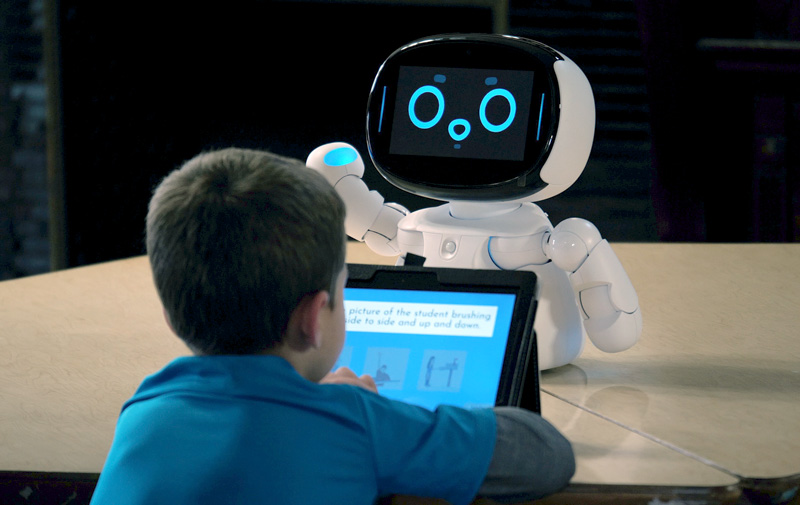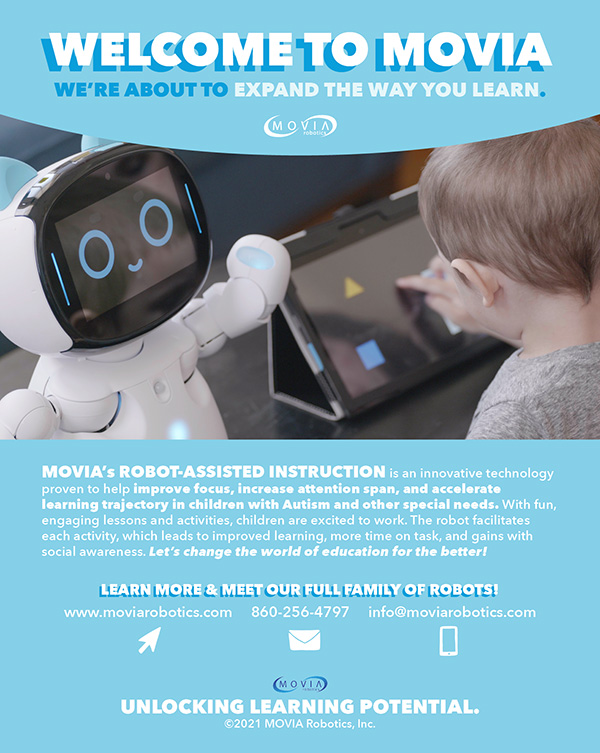I’ve been licensed in California as a Marriage and Family Therapist for over 18 years and my career passion and good fortune has allowed me to treat children with developmental disorders, including Autism Spectrum Disorders (ASD), as well as high functioning adults.

Kebbi is MOVIA’s first “HomePal.” It is an Educational Robot that integrates artificial intelligence, software, and hardware technology to provide a variety of facial expressions, body movements, and communicative interactions. Kebbi provides a unique set of capabilities that work very well for the home or school environment. These interactive capabilities provide users with a heartwarming and educational experience.
Therapy is a profound process that assists autistic individuals in growing and developing new skills and behaviors. However, I always pondered about identifying a remedy, a tangible object, clients can use at home in-between therapy sessions in order to reinforce new skills, behaviors, and patterns in order to expedite learning. I knew therapy-homework was necessary for people to exercise portions of their therapy sessions to promote continuity. All too often much is forgotten from weekly appointments and psychotherapy homework is limited and one dimensional. For decades I searched for a solution until I finally found a company utilizing what they call Robot-Assisted Instruction (RAI), which encapsulated a similar concept of capturing treatment interventions in a tangible product to give people the ability to practice and reinforce the positive changes at home. Moreover, behavioral rehearsal is required to establish growing a new behavior, in order to promote growth.

Lisa Lichtenstein
Working with autistic individuals is challenging in identifying their needs and preferences. In all forms of psychotherapy and behavioral therapy rapport must be established between client and therapist in order for the foundation of trust to be secure and effective. With autistic individuals, their sensitivity to change and stimuli make the delivery of treatment interventions challenging, especially when communication is a limitation. In addition, autistic individuals thrive when stimuli and people are consistent and predictable including body movements, voice tone, and, at times, routines.
Another challenge I’ve found in working with the autistic population is that there is a limitation for clinicians, families, peers, and school personnel in understanding autistic individuals’ thoughts and feelings outside of a school or organization’s curriculum. Said differently, what do autistic individuals desire – what are their personal dreams or aspirations? When the understanding of the autistic population is limited, the supportive people in autistic individuals’ lives are often left feeling confused and perplexed on how to proceed, in order to get inside the minds of their loved ones so they can grow and develop into their highest potential, to live a life with maximum independency, quality, and functionality.
Although I’ve been working with people with Developmental Disorders since my junior year of undergraduate college, I’ve felt limited with treatment interventions up until now. During the pandemic, I happened upon a robot and researched the origins and information surrounding it. I discovered a company, MOVIA Robotics, producing Robot-Assisted Instruction (RAI): a robot, PC, and tablet with a parent, therapist or teacher, guiding autistic individuals to learn new behaviors and develop new skills. MOVIA’s Robot-Assisted Instruction (RAI) systems help children with Autism Spectrum Disorders and other special needs unlock the potential to learn and grow through their unique robotic technology. MOVIA Robotics builds systems to help these children remove barriers to learning, socializing and adapting, while facilitating a positive learning environment at school and at home by dynamically leading them through activities using evidence-based prompting and instructional design. I was astonished to observe how autistic individuals naturally connect effortlessly with the robot. It’s as if the rapport is immediately established, a fundamental in effective therapy.
The second observation in working with the autism population using RAI is that the skills autistic children develop naturally become generalized onto other situations and people. For example, as the robot and child practice a lesson on “How to Ask for Help,” many children carry this behavior over to adults/teachers in their lives.
One of my favorite options I utilize with RAI is the ability to customize communication coming from the robot, as it interacts with my clients. With this modality I’ve been able to ask questions, through the robot, that previously would not elicit a response. When the robot communicates, the majority of the autistic children I’ve worked with consistently respond and initiate further communication. For example, the robot asked one autistic adolescent what he wanted to do in the future, regarding playing the piano. His mother was amazed that he had a plan of forming a band, and had a name picked out for his band. Moreover, the adolescent was prolific in asking the robot questions about “himself” – “Why do you have an unusual name? How old are you?” In the years I’ve worked with this population, the curiosity and questions are not observed significantly toward other people as opposed to the robot. The strategy, in part, is to make communication comfortable and routine so that this behavior is generalized onto other people in the adolescent’s life. The robot also encourages generalization of new skills.
At a public school in Los Angeles, I created a customized program where the robot taught moderate to severe Autistic children. These lessons included Why and How to Wear a Mask, Washing Your Hands, and Practicing Social Distancing, in preparation to returning to a hybrid in-person school schedule. To my happy amazement the children were “glued” to the robot, seemingly enjoying the delivery, the warmth, and the information.
I’m not a neuroscientist but I wonder if there is a familiar and comfortable connection between the sophistication of the RAI and autistic individuals. In any case, I have observed how productive and joyous autistic children respond to RAI and I am excited to discover more about this population. For the first time, when the first conversation was in process between the robot and child, I felt honored to glimpse inside the beautiful, intelligent, and creative mind of an autistic child.
Lisa Lichtenstein has established a multi-faceted career as a psychotherapist practicing for over 20 years. She runs a psychotherapy private practice in Santa Monica, CA, is a Clinical Director in two special education schools in Los Angeles, and is the psychological expert for MOVIA Robotics, focusing on the implementation of RAI for children with socio-emotional, behavioral, communication, and academic challenges. Lisa’s impassioned career promotes people becoming healthier and happier, and her work with MOVIA promotes the use of assistive technology that expedites psychological and emotional growth and profound progress. (License: MFC39938 lisalichtenstein.com│Lisalich@me.com│(310) 980-2179)






Fantastic article which allows us to understand the relationship between the robot and the autistic child!
[…] Read the Article Post navigation […]